June 11th, 2010
At long last I have begun to realize my dream of making a Manitokan! Initiating this blog is part of launching the project. Writing about it will give me the opportunity to experience the creative process more fully. And sharing the experiment will be an impetus to persevere and carry it through to fruition! The seed was planted during a reading with Rachel Pollack at the Tarot School’s Readers Studio in 2008. I had chosen “A Reading to Open the Heart” from Rachel’s inspiring and original book The Forest of Souls which I found to be a wonderfully liberating reading. As she states in the introduction, the object of the book is to “gain new perspectives and explore possibilities outside our normal ways of thought,” and to this end we need to “open the heart.” Before going into a discussion about the Manitokan, I will lay out the questions put forth in the spread and the cards that came up for me. We used Rachel’s exquisite Shining Tribe Tarot for the reading:
1. “What is the heart of my heart?” – Speaker of Trees
2. “What closes the heart?” – The Hermit
3. “What surrounds or obscures the heart?” – Tradition
4. “What is my heart’s aspiration?” – 9 of Trees
5. “What will help open it?” – Gift of Trees
6. “What will carry me through?” – Death
7. “What will I experience?” – Place of Stones
To throw a light on Death, Rachel drew a card which turned out to be the 3 of Trees. She explained that the image reflects the sacrifice of Christ, the crucifixion, but here the sacrifice is joyful, a celebration. And she suggested making a Manitokan as a rite to mark letting go:
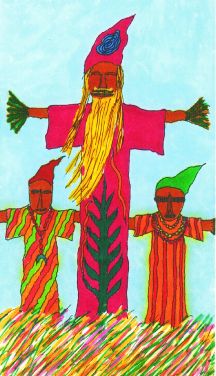
from The Shining Tribe Tarot by Rachel Pollack
A Manitokan, she explains in her book on The Shining Tribe, “is a spirit image formed from a tree by the Ojibwa people of Canada.” Or put differently, it is an invitation for Spirit beings to enter into the tree form and “give life to the material surroundings.” The divinatory meanings Rachel gives to the 3 of Trees are: “Pleasure, abundance, laughter, creativity.” (For quotations in my discussion of specific cards, I refer to the above book).
Conscious of my tendency to take life too seriously, I was charmed. I knew I wanted to make a Manitokan but could not quite figure out where and how. I later had a dream which became an important clue for me:
It is my aunt Jonina’s funeral and people are pouring out of the church into natural surroundings. Outside the church I see a towering wooden cross on which a long batik dress my husband once brought me from the Caribbean moves softly about in the breeze.
I knew immediately that this was the dress my Manitokan would be wearing. Upon awakening, the association to a church window or an altarpiece impressed itself on me. In other words, the frivolous dress which I would wear around the house to sparkle up a day had taken on a sacred dimension. Now that I am about to embark on the creative adventure and delving deeper into the dream, other important associations come to the fore. Firstly, the grace and equanimity with which my aunt Jonina met her death had a transforming effect on me. Death lost its terror. In light of Christ’s crucifixion, her death in my dream implies a resurrection or rebirth on a spiritual level and that rebirth is related to my Caribbean dress.

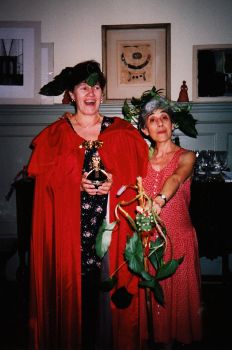
When I think of the Caribbean friends we used to party with in our early New York days, what stands out is my envy of the sensuous ease with which they danced. In the presence of their celebratory naturalness, I felt stiff like a wooden pole, self-conscious, never able to let go. My aunt Jonina was of their kind. She had a marvelous relationship with her body. Dance was in her blood. Dance implies music. And so her funeral ceremony was dedicated to her love of jazz. The meanings that Rachel attributes to the 3 of Trees and the Manitokan – “pleasure, abundance, laughter” – are coming alive for me through my aunt Jonina and my Caribbean dress. The message I take from the dream, and Rachel’s card, is that the split between religion and the body needs to be healed. I need to playfully invite spirit into my body and my material surroundings. In the Christian tradition, the church is the bride of Christ but the sensuous body has been the province of the Devil. As my aunt’s nickname was Unna, which if taken literally means ‘to love’, love and sex are part of the picture. Without Eros, there is no ‘creativity’ which is one meaning Rachel attributes to the 3 of Trees. It all comes together in this one symbolic dream image, does it not? Now the question arises: will the Manitokan lead me towards fulfillment of my heart’s aspiration?
The 9 of Trees shows a sensuous body of a red haired female trapped in a treetrunk and a grieving female kneeling helplessly by. How did this card, which urges us to look at what part of our power we have given away, respond to “my heart’s aspiration”? It was indeed my heart’s desire, I said to Rachel, a calling really, to free this trapped female energy from which I have felt that women in general have become alienated through conditioning. I have delved deep into myths, folktales and fairytales depicting the struggle between the masculine and the feminine powers in the collective psyche of my culture and I have been appalled by the ruthless repression of feminine nature revealed in those tales. To put it succintly, I have experienced myself as a victim of repression and patriarchal indoctrination. The 9 of Trees compels me to acknowledge that by not taking action to reclaim my lost power, I am in fact giving it away. It is mine to take and use responsibly and constructively. But intellectual understanding is one thing, a live experience another. How can it be so complicated to find one’s own power?

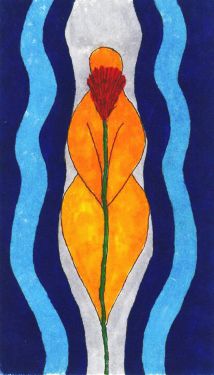
Rachel’s first move in this reading was to pull out the 6 of Rivers showing the dark figure in the treetrunk turned to light. The divinatory meanings of sensuality, pleasure and love, embodied by the figure of light “emerging from between the rivers,” drive home the message of my dream. The key to healing the split is hidden in my flesh, my ousted shadow who inhabits the wilderness, the animal who desires to become integrated.
The figure in the treetrunk on Rachel’s card is Lilith, and the weeping female kneeling helplessly by the tree is the Sumerian goddess Inanna. Lilith is known as Adam’s first wife who refused to submit to him and subsequently gained the reputation of a she-devil, much like Freyja, goddess of love and fertility, who was reviled as a bitch at Thingvellir in 999 by the lawmaker and Christian missionary, Hjalti Skeggjason.
Walking around with my idea of making a Manitokan, I felt a certain kinship with the helpless Inanna who needed a bed and a throne but did not do anything about it. So far I only knew what to dress my Manitokan in. It was all very vague in my mind. Where would I find a tree and how would I put it all together. Like Inanna who was rescued out of her predicament by Gilgamesh, I knew that I would need the help of my handy husband to realize this plan. But it was incumbent on me to find a place. Last weekend I finally did. Curiously, this most ideal place has been under my nose all along, but I did not make the connection.
Four years ago we acquired a tiny cottage in the country which we have named Freyja’s Cottage after the goddess of love and fertility. A short distance away from the house is a grove where previous owners have made a circle of stones. To what purpose, I don’t know. It is just that, stones of various shapes and sizes thrown into a circle with an uncouth patch of turf in the center. For all its crudeness, it immediately implanted in me a sense of sacredness. As I was sitting on the ground the other day, contemplating how I could pay homage to the feeling evoked in me by this place, it dawned on me that this would be the perfect setting for my Manitokan! Without further ado, I started to weed. Ideas poured forth. Full of vigor and anticipation, I stayed with it for a whole sunny day, clearing out turf and grass from between the stones, playing with worms, spiders and bugs. I was happy. And now I cannot wait to go back. A picture of the stone circle in Freyja’s Grove will have to await my return.
Only in retrospect, when I went back to my reading with Rachel, did I realize the correspondence between what I was actually experiencing and the last card that came up for me in the reading: PLACE OF STONES!
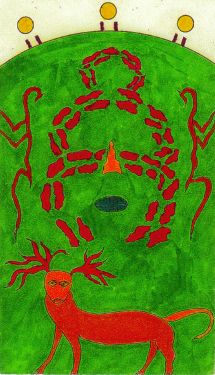
To be continued!
June 19th
Just came back after three glorious days at Freyja’s Cottage. First, let me show you a picture of the stone circle in Freyja’s Grove.

Below you will see Freyja’s Cottage and the view of the magnificent glacier, Eiríksjökull, in the far distance.


On the first day, after I finished clearing the circle of turf and weeds, we toasted Freyja in the evening sun and planted poppy seeds in between the stones. Of course they won’t blossom until next summer, provided the seeds take root in this rugged bed. I see the diaphanous fragility of the brightly colored poppy as a beautiful accompaniment to the grey stone. Now I will just have to keep my fingers crossed.

The poppy is Persephone’s flower. As the story goes, Persephone was picking poppies when Hades, the god of death, burst out of the earth in his chariot and abducted her to the underworld. Eventually, Persephone came to love Hades. She became queen of the underworld and the guide of souls in a dimension that has no road markers.
The following night I had a dream:
I sit on the ground and hammer on an iron rod to which is fastened a blank, pointed, yellow sign.
As it is with dream symbols, this simple image is pregnant with meanings. Suffices to say here, that I had thought about putting up a sign at the entrance to the grove to indicate that it is dedicated to Freyja. That the sign in my dream is yellow, I take as a positive omen. It may indicate that by following the path onto which I am treading, something which was previously buried in the unconscious will emerge into the light. It may point to this path as a way towards liberation of the female energy trapped in the treetrunk, as portrayed in the 6 of Rivers shown above. That it is blank and of my own making, tells me that I am deliberately heading towards the unknown. The act itself, hammering an iron rod, would traditionally be associated with the masculine, and calls to mind Thor and his legendary hammer. Here I am channeling my power into a creative act that seems to lead towards increased consciousness. I woke up feeling invigorated.
The morning after my dream, on June the 17th which is our Indipendence Day, I sat in the sun by the stone circle, intoxicated by the perfume of the birch trees and the birdsong that filled the air – the twittering of the snow bunting, the whinnying of the snipe… This is the task, I thought to myself. To open up to the music of creation. At that moment, I was reminded of a story by Marguerite Yourcenar which I translated from the French decades ago and had all but forgotten, Notre-Dame-des-hirondelles (‘Our-Lady-of-the-Swallows’ – the Icelandic translation was published in Teningur, 1986: 2, under the name Maríukirkja svalanna). It tells of the monk Therapion who came to Greece, on account of a dream, with the intention of exorcising the country whose inhabitants, although devout Christians, were still under the influence of Pan. In a ruthless battle by fire, the monk managed to trap the nymphs who inhabited the trees and the springs in a mountain cave where he endeavored to starve them to death. He had a chapel built in front of the mouth of the cave, and as an ultimate deterrent to block their exit, he erected in the opening between the cave and the church a huge cross with a picture of the crucified Christ painted on it. The nymphs, says the author, who only understand a smile, recoiled in horror from the image of the tortured. When victory seemed in hand, the praying hermit was visited by an ageless woman cloaked in black who asked his permission to enter the cave. She gently moved the cross away from the opening and slipped into the dark. Peeps and the rustle of wings now replaced the cries of agony, and when she returned and opened her black cloak, the monk saw that she carried hundreds of young swallows in the folds of her dress. As if in prayer, she spread out her arms and set the birds free. To the hermit Therapion she said, “They will return every year and you will grant them shelter in my church.” And so, I sensed, was the sanctuary in which I sat and which was presided over by Freyja, a welcoming haven for nature’s spirits.
In the tale, the crucifix functions as a scare that keeps the spirit beings from passing through the church. Its role calls to mind the scarecrow in the farmer’s field intended to keep the birds away. The Manitokan, on the other hand, invites spirit beings to enter into the tree form, much like the Black Madonna in Yourcenar’s story invites the swallows to inhabit her church and thereby reconciles the wild spirits of nature with the celestial spirit of the Christian religion. The link between bird and spirit appears most prominently in the dove, who before becoming the Christian symbol of the Holy Ghost was the attribute of Freyja’s Greek counterpart, Aphrodite, goddess of love, beauty and sexuality.
Following these ruminations, I thought about the next step, finding a tree. For that, I will travel up north to Broddadalsá, a farm by the ocean where my grandmother was born and where I used to spend my summers as a child, as did my mother before me. I will walk in the footsteps of the gods who found the first two people as driftwood on the beach. They gave them life, dressed them up and named them Askur and Embla. Askur lived on in the name of the world tree, Askur Yggdrasils, while Embla vanished into the mists of prehistory. My path will lead back to my roots where I will attempt to find my shadowy foremother about whom I know nothing. I suspect that she and the flaming redhead trapped in the tree trunk of the 9 of Trees may be one and the same. Intent on following my calling, I rolled up my sleeves and used the remainder of my stay at Freyja’s Cottage to weed and groom the pathway leading into the grove.
In the car on the way back home, I heard someone announce on the radio that this day, June the 19th, is dedicated to women’s struggle for equal rights. That we need such a day is testimony to the situation in which we live. On this day, ninety five years ago, women over forty years of age acquired the right to vote in this country. That victory was not won in a day and women are still struggling. Freyja means Lady. The Lord is her masculine counterpart, she his twin and equal. Whole in herself, she represents woman’s quest for independence. She embodies natural wisdom and creativity. Feelings and compassion are her province. Freyja cries. And in her tears of red gold resides the healing antidote to the divisiveness that rules our world. When we have come to recognize Her Universal Ladyship as the Lord’s equal, we will no longer need to allot a special day to the struggle we are commemorating today.
To be continued.
June 24th – St. John’s Day
Yes, Freyja cries. The poets of old equated her tears with gold. According to myth, she cries because she has become separated from her husband Óður. The name Óður refers to wildness and poetry. The implication is that Freyja’s union with wild nature and the inspiration she drew therefrom has been broken. It is as if the poets, lauding her tears as the ultimate treasure, found in her bleeding wound an opening to the divine from which they had become alienated. I imagine her pain helped them understand their own. And through their poems they tried to restore the broken union, to heal that pain.
While I wait for the opportunity to go quest for the right tree to deck up in my Caribbean dress, I am going to explore the reading with Rachel a little further. I told you how at the outset, she pulled out the 6 of Rivers showing the dark figure in the treetrunk of the 9 of Trees turned to light. She then looked at the cards that came before and after the 6 of Rivers in the stack, which as it happened were the 7 and the 5 of Rivers.
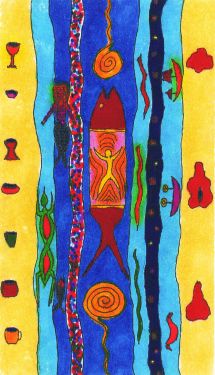
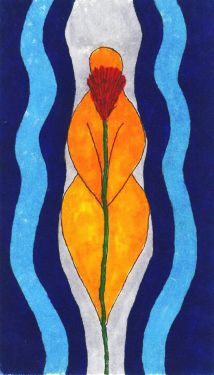

From the Shining Tribe Tarot
“Imagination and grieving,” were Rachel’s key words. The 7 has an aura of playfulness and implies stimulated imagination while the 5 shows the sun, source of life and light, trapped in the dark of the unconscious. The latter card is traditionally associated with ‘grief’ and ‘loss’ and Rachel emphasized the necessity to open the heart to pain. Not my forte, I am afraid. And how have I tried to avoid being hurt? By closing a vital part of myself off from the world. Which brings me to The Hermit, the card that came up in response to the second question of the spread: “What closes the heart?”
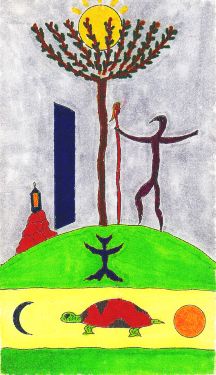
“Have you found the lantern?” Rachel asked, referring to the glowing light beyond the blue door. “Yes,” I responded, “it is in my dreams.” This spontaneous answer is an important clue. It reveals in retrospect an imbalance between the inner and outer life. On my prolonged quest for my self the inner life became all important, and I tended to keep my discoveries to myself. In a culture that demands that the expressed word rest on a rational foundation, it is easier to keep silent about the wonders that wash up on our shores in dreams and imagination. We experience those as sacred because they come from a dimension that lies outside the familiar country of our consciousness. I imagine this is why poetry has a sacred aura in our minds, for if it is any good, it moves us at a level beyond the rational by shining light on deeply felt truths shared by humanity. But I did not have faith in myself as poet. I kept quiet.
The fundamental conflict in the reading expresses itself, as I see it, in the first and the second questions of the spread. The first: “What is the heart of my heart?” emphasizes the questioner’s essence, Rachel explains. What makes her or him unique. It addresses the person’s challenges and opportunities. She began the reading by asking what impression the Speaker of Trees made on me. I had no problem answering that, for the card had taken on a special importance for me based on a meaning Rachel attributes to it in The Forest of Souls: “How can I speak my passion and bring it into the world?” This was my true challenge. To find an outlet for that which was pressing on me from inside. How could I break out of the isolation. Rachel pointed out to me that the Hermit faces the Speaker as if the latter draws his energy from the former. This kindled my hope that, maybe, in the end, my inner explorations would bear fruit.
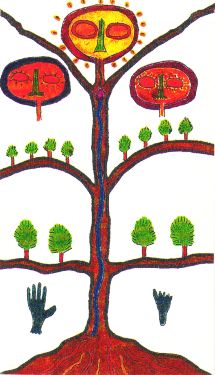
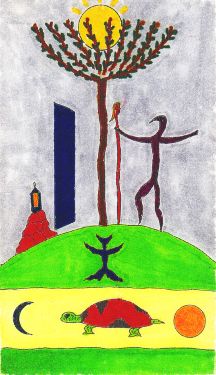
Rachel also underlined the playfulness of this Hermit who, needless to say, shows little kinship with the hermit Therapion in Our-Lady-of-the-Swallows who, as related above, applied himself to exterminating nymphs.
I notice that the Kundalini snake which illuminates the head of the Speaker is the same blue as Lilith trapped in the treetrunk in the 9 of Trees. In the Speaker the block is removed and energy flows freely. It becomes ever clearer that the 9 of Trees, reflecting my heart’s aspiration, is the key card on which the reading hinges. The deamon in the tree is calling out to me!
Next we will address Tradition which came up in response to question number three: “What surrounds or obscures the heart?”
To be continued.
June 29th
To recap, Rachel’s reading, which I laid out at the beginning of these reflections, suggests that making a Manitokan might help me let go of my defences and open my heart. The reading itself is thus an essential part of the process, the groundplan, in fact, on which it rests. I will therefore continue to explore it while I am still waiting to go tree hunting.
Transformation requires a symbolic death, which although not physical is nontheless frightening, because we know what we have but have no guarantee what the new will bring. What we do know is that it will provide us with new growth experiences. This is common knowledge. My reading points the way to transformation through death. As you will remember Death came up in response to question number six: “What will carry me through [to the opening of the heart]?”

On some level we know that there is no turning back once the step is taken. I know that by following the blank, yellow roadsign that showed up in my dream, old inhibiting defenses will have to be left behind. I must be prepared to feel pain. That is why stepping off the cliff (figuratively speaking!) is so frightening.
To pick up where we left off last time, Tradition turned up in response to question number three: “What surrounds or obscures the heart?”
It seems self-evident that tradition would counter my objective for chosing this particular reading, namely to “gain new perspectives and explore possibilities outside [my] normal ways of thought.” (I refer to my quotation at the beginning of this blog from Rachel’s The Forest of Souls.) Tradition, as I understand it, is a conservative edifice built by man and upholds the interests of the ruling power. We tend to buy into tradition as if it were a natural law. It gives structure and form to our lives. It makes us feel secure. We don’t question it, until something in us rises up against a behavior pattern to which we have obediently adapted but which goes against our personal interest. We become neurotic, imbalanced, as our innermost self, like a wounded animal, tries desperately to get through to us and guide us towards healing. Within us a war between mind and heart, between reason and feeling is set in motion. Because our culture elevates the former above the latter, it is an uneven war and hence tends to drag out. To break away from tradition and indoctrinated behavior patterns is a fight with a terrifying dragon as is reflected in countless myths and fairytales. The female figure trapped in the treetrunk in the 9 of Trees whom my heart desires to free, is guarded by that ferocious monster. If you take another look at the card, you will see that in this case it is a serpent, but mythologically it really is the same thing. The Latin draco denotes both a serpent and a dragon.

The image on the Tradition card would seem to reflect my feeling. A purple flower in a golden circle is surrounded by massive stone figures. For that is what they are. Rachel tells us that she drew the inspiration for this card from five stones arranged in a circle which she encountered while visiting the Dead Sea. She envisioned them as spirits, and protective spirits at that. For me they represented the petrified tradition I was struggling against. But “petrified tradition,” Rachel pointed out to me, “cannot prevent the flower in the center from growing.” She was right. I told her about the flower in my dreams that I was trying to fiercely protect and I showed her the bracelet I happened to be wearing.

I had just made this bracelet based on a dream I had at the beginning of my journey towards self-knowledge. It is a dream that has lived within me ever since:
I see an image which I recognize as one I embroidered in cross-stitch on a painted piece of cloth when I was a young girl. It is an image of a sunset with a sky glowing in orange and blue-green over a dark forest. Then the image is flipped around and I am shown the reverse: a single red rose embroidered freehand on the shadowy background of the trees.
My bracelet reflects the two sides of the dream image, the forest and glowing sunset on the one hand and the red rose in the shadow on the other. The message of the dream was clear enough. Embroidering that image at the age of puberty, I followed a pattern which had been laid down for me in detail. Now the single red flower, embroidered freehand on the shadowy background, called out to me to use my creative imagination, and passion, to bring my individual self into the light.
In the Shining Tribe Tarot, the image of the five spirit rocks replaces the traditional one of the High Priest (Hierophant) or Pope in older decks, and the divinatory meanings Rachel gives to the card such as, “Finding your path, either through tradition or your own searching. A sense of protection, of trust and hope,” make me realize that my personal struggle has narrowed my view of tradition. I am obliged to recognize that although I feel the absolute need to search for my path outside established tradition, tradition has helped me understand this compelling need. On my journey I have learned to trust my dreams and intuition as did my ancestresses, many of whom were burned at the stake for straying off the path laid out for them by patriarchy. It is from this source of inner wisdom that my sense of protection and hope comes from. The challenge for me is to trust the world.
In Tradition we have a circle of stones. Contemplating the reading in its entirety, I am struck by the fact, that all of the seven cards that came up for me either refer to or prominently figure trees and stones, except Death which was overlaid by the brighter and more joyful Manitokanac (pl.) in the 3 of Trees. This brings us back to the task at hand: the Manitokan which, if all goes according to plan, will be erected in the center of the stone circle in Freyja’s Grove. Tomorrow I go up north to the shores of my grandmother’s birthplace to search for a tree.
To be continued.
July 4th
We arrived at Broddadalsá in the early afternoon of last Wednesday.
It was when on our way back we passed the blue sign with yellow letters, pointing the way to the farm, that I thought of the blank yellow road marker in my dream. The process had led me to the homestead of my ancestors which, with its wealth of cherished memories, occupies an important place in my heart. I was grateful. It had been a most memorable, and successful, visit. An important step on the way, I felt. The images below tell the story of my quest for a tree for the Manitokan.
My companions on the quest
Left: David, my former teacher who now owns half of the land belonging to the farm Broddadalsá.
Right: Svava, former mistress of the other half of the land, now owned by her son Torfi and his wife Unnur.
Between them is my husband, Herbert.
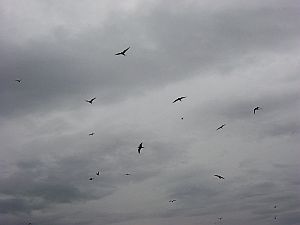
The arctic terns, who had laid their eggs in the sand, were not happy with our intrusion. Their screeching filled the air and they took turns diving over our heads in an aggressive attempt to scare us away. We empathized with their worry and took their threats in stride.

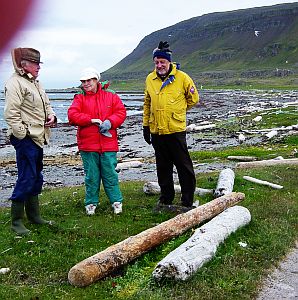
Now we needed a cross bar to provide the Manitokan with arms. Svava thinks this one is really good.
Or is this one maybe better? We decided to take both and try them out on location.
Material for the Manitokan ready to be transported to Freyja's Cottage.
I believe that we all enjoyed this little adventure. Afterwards we had a hearty supper and toasted the Manitokan-to-be. Around noon the next day, we took leave of David and headed south with Svava. We arrived at Freyja’s Cottage in pouring rain and brewed some coffee to perk ourselves up. The treetrunks we left by the stone circle in the grove. There they await our return for further processing. By evening we arrived in Reykjavik after a mission which had proved to be successful beyond my expectations. I was happy.
To be continued.
July 8th
The question that haunts me is, what happened to Embla, the first woman whom the gods created from a tree they found on the beach? The first man, Askur, was created from an ash tree and so is the world tree, Askur Yggdrasils, an ash. We don’t know what kind of a tree embla is. Today the name has been given to an improved breed of the Icelandic birch, but the mystery of Embla as the primary source of humanity remains unresolved. Looking up the B-rune, Berkana or bjarkan, associated with the birch tree, I come across an interesting theory by rune scholar Stephen Flowers (alias Edred Thorsson), who holds that this rune of transformation and becoming refers originally not to the birch tree as such, “but rather to the Birch-Goddess – Freyja.” (1998. Northern Magic: Rune Mysteries and Shamanism, p. 93)
In her chapter on the Place of Trees, Rachel Pollack reminds us that there were two trees in Eden, the Tree of Knowledge and the Tree of Life. God only forbids Adam and Eve to eat of the Tree of Knowledge, but when they have eaten the apple regardless, God worries that they will now reach for the fruit of the Tree of Life and live forever. Rachel suggests that the Tree of Life was invisible to Adam and Eve until they had eaten of the Tree of Knowledge. She also tells us that some rabbis and others have suggested that the Tree of Life was inside the Tree of Knowledge.
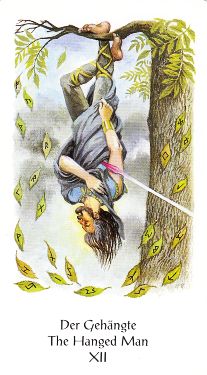
From Tarot of Northern Shadows
Reproduced by permission of the company © 1997
AGM AGMuller Urania, Switzerland.
Further reproduction prohibited.
In the Eddic poem, Sayings of the High One, we learn that Odin obtained knowledge of the runes after having hung wounded and fasting on the Askur, the world tree, for nine days. This was knowledge that emerged from within. Rún (‘rune’) is a woman’s name and the meaning of the word is ‘secret’. We may surmise that Odin received this gift from his feminine counterpart, a ‘secret counselor’ hidden in his masculine nature.
Going back to my reading with Rachel, question number five in the spread asked: “What will help open [my heart]?” Gift of Trees came up. This gift, the cards say, will help me release the energy trapped within and express my passion.

Rachel asked what “the snake” meant to me. “Wisdom,” I replied. She emphasized how this wisdom springs from the heart but has not to do with knowledge. But what about the two entwining snakes, what did they mean to me? I mentioned the healing symbol, the caduceus of Hermes which has been adopted by the medical profession. “But I guess that is not what you are asking me,” I added, recognizing that this piece of knowledge did not have to do with my personal experience of the symbol. The green snake, I concluded, meant healing and growth to me, the red one passion. Rachel then drew my attention to the gold nugget the snakes hold between their mouths, the philosophers’ stone, panacea and ultimate goal of the alchemist.
If you take another look at the Speaker of Trees above, you will see that the two snakes have merged within the trunk of the tree, calling forth an illumination in the Speaker which enables him or her to express wisdom that had lain concealed in the unconscious, thus expanding his or her consciousness, and ideally that of the collective. This is the moment of magic experienced by Odin while he hung in the branches of the world tree. It was an orgasmic experience as is betrayed by his screaming at the moment of revelation.
“The fruit is the Gift of Trees,” Rachel explains in the text accompanying the card. To me she pointed out that the fruits are in the shape of hearts. I wonder what was the shape of the apples Idun (Iðunn), wife of Bragi the god of poetry and rhetoric, kept in her wooden box. They were gold and sustained the youth of the gods. The name Idun derives from the verb iða which implies constant movement as opposed to stagnation. Idun’s apples, I imagine, refer to the fruit of the Tree of Life. In the myths, Idun is portrayed as a mere instrument in the service of the gods, an object with no will of her own. As wife of the god of poetry, she would have been his muse, not a creator in her own right. It would seem that it has been the fate of woman to carry this projection for man. How does woman gain access to the fruit of which she is the guardian? My mind wanders to the crying Inanna who kneels helplessly by the tree in the 9 of Trees, to the sensuous Lilith trapped in the trunk, guarded by the green serpent of wisdom and growth. I think of Freyja who cries tears of red gold because she has been seperated from Od (Óður), the ‘wild other’, her uncivilized counterpart and source of poetic inspiration. How do I open myself to receive the gift of trees? Where do I find the key?
The truth of the matter is that the key was in my dreams the night before last. Or rather it was not, but I knew where it was. Rachel calls the central Manitokan in the 3 of Trees Grandfather. It was a Grandmother who opened the door for me in the dream, a composite of grandmothers whom I have known in my life and who have now passed over. And she did not exude joy, nor did she give me the impression that she reveled in abundance. The key, the dream revealed, is with the granddaughters.
Gift of Trees in the Shining Tribe Tarot corresponds to the Queen of Wands in the Rider-Waite deck shown below.
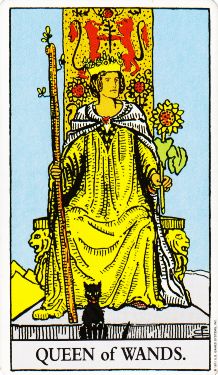
From the Rider-Waite Tarot Deck®, known also as the Rider Tarot and Waite Tarot, reproduced by permission of U.S. Games Systems, Inc., Stamford, CT 06902 USA. Copyrights © 1991 and 1971 respectively by U.S. Games Systems, Inc. Further reproduction prohibited. The Rider-Waite Tarot Deck® is a registered trademark of U.S. Games Systems, Inc.
I have long been attracted to the Queen of Wands. It is a card that expresses openness, independence (I take that meaning from her cat) and determination. It reflects to me a clear-headed, composed and enterprising woman. The firm grip she has on her wand tells me that she is in control of and knows how to channel her masculine energy. She is not one of those innumerable heroines of myth and fairytales who need to be rescued by a hero, she is perfectly able to take care of herself.
This queen has many traits in common with Freyja as she is portrayed in the myths. She radiates the healing solar energy and sexual openness incarnated by the goddess of fertility and love, and the cat was Freyja’s attribute, as it is that of the wise woman or witch. The lions adorning the arms of her throne correspond to the two cats who drew Freyja’s chariot on her shamanic journeys. And last but not least, her wand associates this queen with the völva, ‘wise woman and prophetess’, whose attribute was a staff. And so it seems to me that, with her distant look, this queen is a visionary.
In her book on the Shining Tribe Tarot, Rachel tells us that the Gift cards can represent the decisive moment on a quest, when the seeker receives a gift which will help the person move on towards the fulfillment of his or her mission. This gift can come in many guises. It can be a synchronicity experienced as a guidepost or a confirmation on the path. Or it can be a special helper or a teacher who appears at a crucial moment. Rachel has been one such teacher on my journey, and her “Reading to Open the Heart” has motivated me to explore new venues. That the Gift of Trees with its heartshaped fruit came up as a helper in this reading centering around the heart, feels like a meaningful synchronicity. The card’s correspondence with the Queen of Wands, which to me incarnates Freyja’s energy, I experience as a confirmation, for the goddess who taught the art of seiður (an ecstatic rite of divination and healing) to the æsir-gods has been at the heart of my research and writing for a very long time.
July 13th
Arrived at Freyja’s Cottage yesterday (July 10th). This morning I noted to my surprise and delight, that the Thorn Rose we planted last summer is displaying a number of buds. In the spring we did not believe it would pull through, in fact it was deemed dead, but I still hoped for a miracle. I bought it because of the name. Thorn Rose is the Icelandic name for Sleeping Beauty, a story that has been of special interest to me.
The discovery of the buds gave a new slant to my Manitokan process. In the previous installment I wondered about the fate of Embla, the first woman whom the gods made from a tree they found on the beach, and I suggested that knowledge of the runes was mediated to Odin through his feminine counterpart. Now the valkyrie Sigurdrifa has come to the fore and claims attention. I was working on the “antichamber” to Freyja’s Grove when the connection between the Manitokan and the rose buds came to me. This is the key, I thought to myself. The rose buds, that is.
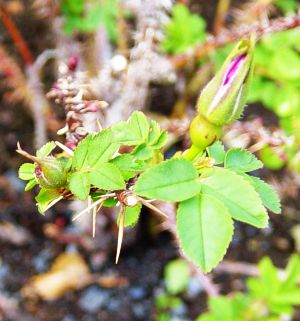
We all know about the spell put on innocent Thorn Rose by the thirteenth fairy but what do we make of the spell Odin Allfather put on the valkyrie, Sigurdrifa? According to the Eddic poem, Lay of Sigurdrifa, the valkyrie went against Odin’s wishes and favored the wrong party (from the god’s point of view) in battle. In another poem, we understand that to do otherwise, she would have broken vows she had given to a young king when she was twelve. I am not going to beat about the bush here. The apparent motive behind the tension between Odin and the valkyrie is, that at the onset of menstruation, woman enters into a rhythmic dance with the moon. With his helmet of gold, Odin was a solar god, and so were the dazzling valkyries presented as solar figures who descended on their steeds from above, heading for an embrace with their lunar other. The archetypal story behind this underground encounter is Freyja’s descent for four nights into a stone, where she slept with four dwarfs in exchange for her precious jewel, Brisingamen. Needless to say, the tale is given a scandalous twist in the literature.
In order to obey Odin, Sigurdrifa would have had to betray the lunar pole of her nature and adapt herself to the solar priciple favored by the patriarchy. Instead of the lunar year with its thirteen moons, which accords with woman’s menstrual cycle, patriarchy introduced the solar calendar comprising twelve months. Women were forced to renounce their lunar deity, with whom they had a deep and creative relationship, and submit themselves wholly to the patriarchal solar god, incarnated on the earthly plane by the solar hero. To convert them, their lunar nature was demonized. This, I venture to say, has produced a discord in many a woman’s psyche.
Odin stuck Sigurdrifa with a “sleeping thorn” and decreed that she would never again win victory in battle and that she would marry. The lunar cycle embodied by woman through her menstrual nature holds his mortality up to man. In a nutshell, the valkyries personified the cyclic pattern of death and regeneration inherent in nature. Odin, on the other hand, strove for immortality. The spell he put on Sigurdrifa was an attempt to conquer death. In the Saga of the Volsungs, the valkyrie’s name is Brynhildur. On the earthly plane Brynhildur’s father followed through on the god’s decree and threatened to disavow his daughter and make her destitute, if she did not obey him and marry her suitor, Gunnar (ironically the namesake of the old warrior, Helm-Gunnar, whom she had disobediently felled in battle – a foreboding of Odin’s own demise and the crumbling of his power). In other words, Brynhildur would have become a “bag lady” had she not given in to the god’s and her father’s will. The god’s decree resulted in Brynhildur’s having to renounce her valkyrie status and dedicate herself solely to that of a wife. Through his control of woman, man endeavored to take control of death.
The name Sigurdrifa I take to mean ‘she who embodies energy that leads to victory’. In the lay that is named for her, she teaches rune wisdom and gives good counsel to Sigurd, whose name implies victory. The relationship between their names alludes to the hidden twinship we detect in Odin’s acquisition of rune knowledge while he hung on the tree. Sigurdrifa is the driving force in Sigurd’s psyche. Embodiment of wisdom, she is in us women, too. A guide who helps us incarnate our talents and become the best we can. She is the driving force behind the transforming evolution in women and men alike. This is the energy of the God Mother hidden within. In order to get us to the place we need to be, she takes on many guises. She may lead us into situations which at first seem to work against us, like the thirteenth fairy did with Thorn Rose, but in the end it turns out to have been a necessity which transforms, not only the individual, but the collective as well. The king, Thorn Rose’s father, made a vain effort to deny his daughter’s menstrual nature and thereby stunted her growth for a time. In fact, for a very long time. The fairy godmother’s move was to shock the collective into recognition of the gift that through repression had become a curse. I take the buds on the struggling Thorn Rose at Freyja’s Cottage as a sign, that our collective Grand Mother will regain her place of reverence and blossom like never before in her grand-daughters.
It is Sunday the 11th of July.
I did not sleep much. Felt all tensed up and looked at my calendar to have my suspicion confirmed: it was indeed the night of the black moon. And a total solar eclipse to boot, signifying the merging of the heavenly bodies. It was on such a night that Freyja received her Brisingamen. During those waking hours, I saw a correlation between the secret hidden in the runes and the theory which holds that the Tree of Life is hidden inside the Tree of Knowledge. The same priciple applies to words like húsfreyja, which in Icelandic denotes a married woman, or one who heads a household. She is the lady of the house. Freyja means ‘Lady’. This implies that the goddess is in every grown woman and that every woman has the potential to incarnate the talents and qualities our culture has projected upon the goddess of love and fertility. The B-rune is a letter that facilitates communication, but hidden within it is the power of regeneration and transformation, of “new growth from old roots”. It seems that the cultivators, who gave the name Embla to the improved breed of the Icelandic birch tree, hit the nail on the head.
Freyja’s Brisinga men (this is how it used to be written, as two separate words) is a puzzle which scholars have not yet been able to solve. The word men means ‘pendant’ in Icelandic, but what has been ignored is that men is the Indo-European “moon” root from which are derived the words menstruation and menses. The focus has been on its meaning as a necklace. Fifteen years ago I had a dream which finally yielded its gold to me this morning. At the time, I was somewhat hesitantly beginning to reveal my interest in dreams and was a member of a dream group in New York. In fact, the dream betrays my fear of being identified with the New Age wave which was held in rather a low regard by the intellectual community. The essence of the dream was as follows:
I am in a car with my therapist Hulda (‘the hidden one’) and her husband (unknown to me). The husband is at the wheel and I sit in the back. I am holding an oblong gray stone in my hand, a most ordinary stone spotted with lichen. “We are now seeing this craze with stones,” the man says somewhat contemptuously. I keep silent and do not reveal my stone. Then, suddenly, the stone crumbles into three pieces in my hand. I look at it with disbelief and say: “This stone does not come from the moon.”
Eventually I came to see the stone as representing a petrified attitude in myself that needed to dissolve. My name Hall-fríður is a composite which means ‘stone’ and ‘she who is loved’. It was close enought to lead me on to Freyja who was loved in the stone. That I was on the right track was confirmed by my dreams which were filled with necklaces galore. I did not know about the relationship between men and moon then. When that connection dawned on me, it felt like a revelation. It meant that Freyja’s descent and acquisition of Brisingamen is an image of the “sacred marriage” (hieros gamos) which the alchemists regarded as the culmination of their work. But the connection with the “stone from the moon” in my dream did not hit home till this morning. I now know that the stone from the moon is “the gold nugget” held between the mouths of the snakes in the Gift of Trees. It is “the stone that is not a stone”, the healing elixir sought by the alchemists.
In the dream the masculine is driving me. But Hulda was sitting by the driver’s side for a reason. Unknowingly, I was guided onto a track that has led up to my encounter with the Gift of Trees which holds out the promise of transformation through surrender. I certainly knew about the philosophers’ stone at the time of the dream through my Jungian studies, but it is first now that the pieces fall together. This “stone” is in Freyja’s possession and so it is in my possession also, as it is in that of every woman. Man has sought possession of it through woman, as is born out by the soror mystica or ‘mystical sister’ who works by the alchemist’s side as his “assistant”. Might a guide be a more appropriate word? Hulda, ‘the hidden one’, is this ‘mystical sister’ in my dream, the one who guides my masculine side, the husband at the wheel, towards the desired goal.
A stone in the shape of a heart, dug out of the earth while I was grooming the "antichamber" to Freyja's Grove, felt like a playful sign on the way.


We left the soaking wet tree to dry in the grove. Tomorrow we go back and continue the process. To be continued.


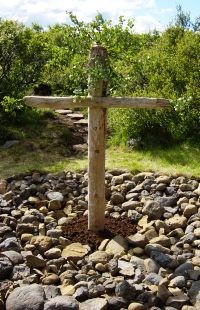
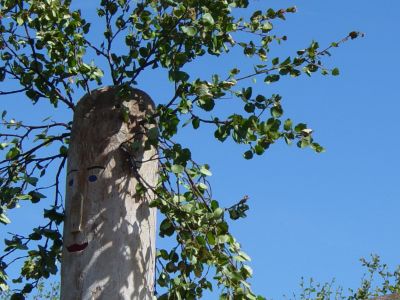
The final touch was the Caribbean dress. A perfect fit, don’t you think? We named her Embla. And now I invite you to listen to her guiding wisdom:
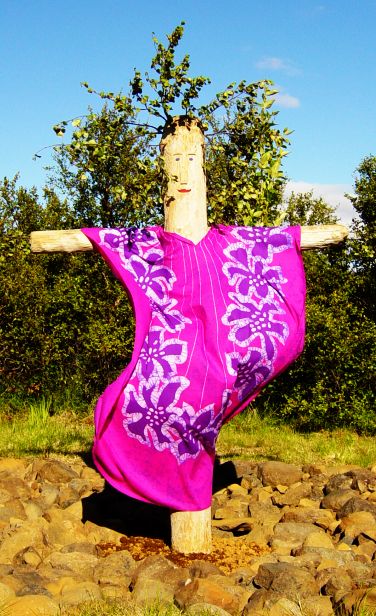
Let go of your resistance!
Spread out your arms and
come join me in the dance of life!
Sway with the music that
pervades creation,
feel how it pulsates in your
veins, now forceful and
fast, now tender and slow,
attune to its rhythm,
be alive!
Or maybe you prefer to join me in
silent meditation?
Spread out your arms and let go of
defenses. Stay open to
whispers from the
wellspring in your depths. Be
guided by this voice of wisdom, accept its
gifts, without fear, with
responsibility, so that you may become the
poem or pearl
you
were meant to be.


